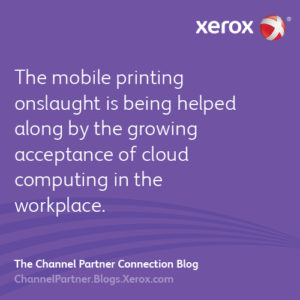(Note: This article was first published on IT:Connect & Expand, a Channelnomics blog presented by Xerox for managed service providers.)

What was once the purview of the mobile executive is quickly becoming a fundamental need for employees at every level who now see print capabilities among the basic work necessities for their multi-use smartphones, tablets, ultrabooks and other personal devices.
Driven by the Cloud
The mobile printing onslaught is being helped along by the growing acceptance of cloud computing in the workplace. According to Forrester Research, there are 400 million mobile workers worldwide – a number that continues to climb with the adoption of advanced mobile devices and the proliferation of mobile cloud-computing applications and services. Among this user base, the ability to print on-the-go from any location – on the road, in the office or from home — remains one of the most desired capabilities, the Forrester research shows.
Going Mobile – Four Key Requisites
From the managed print services provider’s perspective, this rapid adoption presents a significant opportunity, provided some basic considerations are made regarding service delivery. Here are the four key prerequisites for a successful foray into mobile printing services:
1 Solid foundation
Most mobile printing solutions depend primarily on cloud-based services, meaning system reliability and uptime are paramount. Users will expect the system to work 24/7 and are likely to dismiss the service if it fails more than once or twice. Beyond system stability, the basic mobile printing infrastructure needs to be scalable and able to deploy any number of printers using reliable, repeatable set-up procedures and consistent user experience.
2 Flexibility
Organizations are likely to leverage their mobile printing capabilities in a number of ways, including a mix of public and private venues that might be available to both their workers and their own customers. As a result, the basic mobile print offering should be capable of functionality including auto discovery of print locations via GPS, support for free-to-user or pay-per-use arrangements, and the ability to layer on secure document processing and release authorization, particularly for unattended printers.
3 Enterprise chops
At the large enterprise level, service providers are likely to encounter the need for more robust controls, such as the ability to configure printers to require access control lists for internal users while supporting open printing for visitors. Other requirements: integration with existing print management systems, and the ability to deploy a hybrid cloud/CPE solution with certain assets limited to corporate servers for data security and integrity assurance.
4 Baked-in green
One underserved selling point in the value proposition for managed mobile print services is the solution’s ability to reduce unnecessary output and improve environmental responsibility. At its heart, mobile printing is really about allowing users to print only what they need when they need it. Coupled with features like approved user lists and print release codes, the mobile printing solution can significantly reduce paper waste and consumables used in unnecessary printing.
At Work, At Home, In Public?
In a world where end users are printing less, the focus is shifting toward being able to print from any location at any time and from any device. For increasingly mobile-centric organizations, the onus is on services providers to offer holistic, value-added printing solutions that are not just limited to the workplace. The mobile printing experience must appear seamless and consistent whether the user is at work, at home or in public.
With the right kind of planning and focus, managed print services providers have an opportunity to provide incremental value to their corporate clients with a mobile print solution as part of their go-to-market strategy.
Subscribe to the Channel Partner Connection and receive email updates when we publish a new article.



